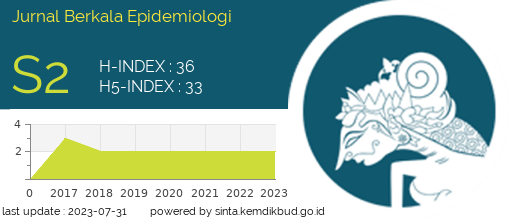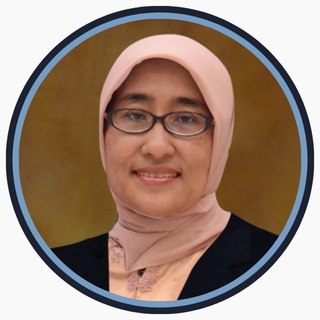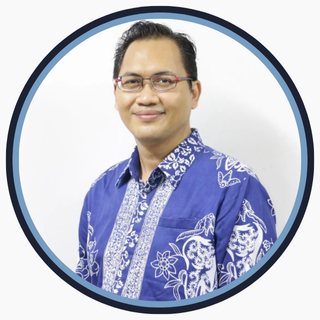Risk Difference of Stroke Based on Biological Risk Factor for Working Age Group
Downloads
Indonesia is a country with the highest stroke mortality in Southeast Asia. An increase in cases of stroke in the productive age-related to unhealthy lifestyles in Indonesia. This study aims to analyze differences in stroke risk based on biological risk factors at a productive age. The study used a case-control design with a sample size of 33 people in the case group and 33 people in the control group, the sample was selected using systematic random sampling techniques. This research was conducted at the Haji Public Hospital Surabaya in October-May 2015. The dependent variable is the incidence of stroke, while the independent variables are age, hypertension, diabetes mellitus (DM) type 2, hypercholesterolemia, and coronary heart disease. Data are presented descriptively and analyzed bivariate and multivariate with Odds Ratio (OR), Risk Difference (RD), and logistic regression. The results showed that history of hypertension (OR = 45; 95% CI = 8.75-274.4; RD = 0.73), type 2 DM (OR = 5.71; 95% CI = 1.26-29 , 39; RD = 0.39), hypercholesterolemia (OR = 18.6; 95% CI = 3.41–133.91; RD = 0.57), and coronary heart disease (OR = 13.91; 95% CI = 1.61-311.02; RD = 0.49) affect the incidence of stroke in the productive age group. It was concluded that in the productive age group, hypertension, type 2 diabetes, hypercholesterolemia, and coronary heart disease can increase the risk of stroke. Education about stroke needs to be done especially about the prevention of hypertension, type 2 diabetes, hypercholesterolemia, coronary heart disease, and monitoring patients at risk of stroke with regular health checks to prevent strokes at productive age.
Burhanuddin, M., Wahiduddin dan Jumriani, 2012. Faktor risiko kejadian stroke pada dewasa awal (18–40 tahun) di Kota Makasar Tahun 2010–2012. http://repository.unhas.ac.id/(sitasi 17 November 2014).
BPS, 2010. Proyeksi penduduk Indonesia 2010– 2035. HYPERLINK "http://www.bps.go.id/ aboutus.php?sp=1”http://www.bps.go.id/aboutus. php?sp=1 (sitasi17 November 2014).
CDC, 2013. Stroke facts. HYPERLINK "http://www.cdc.gov/stroke/facts.htm”http://www.cdc.gov/ stroke/facts.htm (sitasi 17 November 2014].
Bethesda Stroke Center, 2012. Mengendalikan faktor risiko stroke. HYPERLINK "http://www. strokebethesda.com”http://www.strokebethesda. com (sitasi 9 Juni 2015).
Depkes, 2008. Laporan nasional riset kesehatan dasar 2007. Jakarta: Badan Penelitian dan Pengembangan Kesehatan Departemen Kesehatan RI.
Depkes, 2014. Laporan nasional riset kesehatan dasar 2013. Jakarta: Badan Penelitian dan Pengembangan Kesehatan Departemen Kesehatan RI.
Dinas Tenaga Kerja Transmigrasi dan Kependudukan, 2014. Manfaatkan bonus demografi: pilar produktivitas dan pertumbuhan ekonomi. Buletin kependudukan Edisi III Tahun 2014: 4–6.
Handjani, A., Roosihermiatie, B., dan Maryani, H., 2010. Faktor-faktor yang berhubungan dengan pola kematian pada penyakit degeneratif di Indonesia. Buletin penelitian sistem kesehatan Vol. 13 No. 1 Tahun 2010: 42–53.
Kemenkes, 2012. Gambaran penyakit tidak menular di Rumah Sakit Indonesia Tahun 2009 dan 2010. Buletin jendela data dan informasi kesehatan Vol. 2 Semester 2 Tahun 2012: 23–24.
Murti, B., 2003. Prinsip metode riset. Yogyakarta: Gadjah Mada Univ. Press.
Nastiti, D., 2012. Gambaran faktor risiko kejadian stroke pada pasien rawat inap stroke di Rumah Sakit Krakatau Medika Tahun 2011. Skripsi. Jakarta: Universitas Indonesia.
Noviyanti, R.D., 2014. Faktor risiko penyebab meningkatnya kejadian stroke pada usia remaja dan usia produktif. Berkala epidemiologi Vol. 10 No.1 Tahun 2014: 1–3.
Pinzon, R., 2010. Awas stroke: pengertian, gejala, tindakan, perawatan, dan pencegahan. Yogyakarta: Andi.
Rachmawati, I., 2009. Faktor risiko kejadian stroke pada penderita diabetes mellitus. Skripsi. Surabaya: Universtitas Airlangga.
Rahayu, E.O., 2015. Perbedaan risiko stroke berdasarkan faktor risiko biologi dan perilaku merokok pada usia produktif. Skripsi. Surabaya: Universitas Airlangga.
Rau, M.J. dan Kotoko, F., 2011. Faktor risiko kejadian stroke di RSUD Undata Palu Tahun 2011. http://publikasi.stikesstrada.ac.id/(sitasi 18 November 2014).
Riyanti, 2011. Hubungan antara kadar glukosa darah terhadap kejadian stroke iskemik. Skripsi. Surabaya: Universitas Airlangga.
Sari, D.K., 2012. Faktor risiko kejadian stroke iskemik pada usia produktif. Skripsi. Surabaya: Universitas Airlangga.
Siregar, F.A., 2002. Faktor risiko kejadian stroke penderita rawat inap RSUP Haji Adam Malik Medan. Skripsi. Surabaya: Universitas Airlangga.
Space, J.D., 2012. Stroke prevention, treatment, and rehabilitation. New York: Mc Graw Hill.
Tjikoe, M.A., Loho, E. dan Ali, R.H., 2014. Gambaran hasil CT-scan kepala pada penderita dengan klinis stroke non-hemoragik. e-clinic Vol. 2 No. 3 Tahun 2014: 1–2.
WHO, 2007. Prevention of cardiovascular disease guidelines for assessment and management of cardiovascular risk. http://www.depkes.go.id/ download.php?file=download/pusdatin/buletin/ buletin-ptm.pdf (sitasi 11 Januari 2015).
WHO, 2013. Noncomunicable disease. HYPERLINK "http://www.who.int/mediacentre/factsheets/ fs355/en/%20” http://www.who.int/mediacentre/ factsheets/fs355/en/(sitasi 11 Januari 2015).
Yastroki, 2011. Waspada stroke. HYPERLINK "http://www.yastroki.or.id”http://www.yastroki. or.id/(sitasi 30 November 2014).
Yulianto, A., 2011. Mengapa stroke menyerang usia muda?: penyebab, gejala, dan pencegahan stroke yang menyerang usia muda. Yogyakarta: Javalitera.
- Every manuscript submitted to must observe the policy and terms set by the Jurnal Berkala Epidemiologi
- Publication rights to manuscript content published by the Jurnal Berkala Epidemiologi is owned by the journal with the consent and approval of the author(s) concerned. (download copyright agreement)
- Complete texts of electronically published manuscripts can be accessed free of charge if used for educational and research purposes according to copyright regulations.

JBE by Universitas Airlangga is licensed under a Creative Commons Attribution-ShareAlike 4.0 International License.























